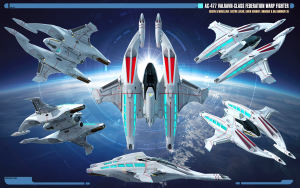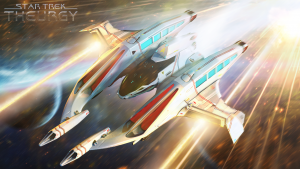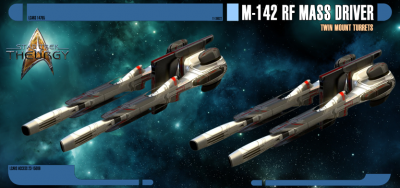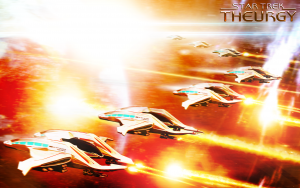AC-477 Mk I Valravn
From Star Trek: Theurgy Wiki
This was the first iteration of the Valravn-class Warp Fighter. With origins in the Interceptor Program, this fighter was designed to make the interceptor role in Starfleet obsolete. This, in how it was the perfect combination between an space superiority fighter and a fast response interceptor. The Valravn were capable of fast response, territorial defence, but also prolonged engagements. They could strike fast, hard and then regroup for another pass if so necessary, and like traditional space superiority fighters - like the Valkyries - their high manoeuvrability could also hold their own in a dogfight.
The Valravn-class Warp Fighters were the kind of crafts that were commissioned to USS Orcus, and the 16 crafts were the only ones assembled.
Fighter Demonstration
Production History
The formation of Starfleet Aerospace Command is heavily influenced by the successful deployment of Peregrine-class fighters aboard the starships serving as carriers in the fleet. The year 2375 - after the conclusion of the Dominion War - the AC-205 Mk I Valkyries were deployed. These fighters were assigned to the USS Typhon (TNG game: Star Trek: Invasion). They were initially designed as a carrier-based fleet engagement craft. Initially, the design proved successful, with a high survivability rate matching the heavy fire power available to bring down larger ships. In learning that a full squadron of Valkyries would still require a lot of support from for engagements of a Dominion-War level threat, Starfleet deemed that the attack fighter needed an upgrade. By 2381, these fighters are still being deployed in fairly limited numbers - shuffled around the fleet.
Another development at the time was that a group of influential admirals in the fleet demanded to form a new department that hand-picked the Conn officers with the most tactical training. It was the only way, they reckoned, to ensure that the fleet used the right kind of pilots for these fighters. The original score of 400 personnel - the fleets new Tactical CONN officers - served as the foundation for a new and more organised department for fighter pilots. They accepted only the highest scoring Conn or fight-trained Security or Tactical Cadets, and then dealt them another year of training in the fields they lacked from their Academy training. White became the chosen colour for the department, and the admirals that rode this project into history became the core of the Aerospace Command.
While the Valkyrie program - mainly under Rennan Cooper's direction - was a success, there was a competing development program led by the Advanced Starship Design Bureau which focused on territorial defence and the interception deployment of small crafts. It was the Interceptor Program led by Lieutenant Commander James Knight. While the Valkyries held a Space Superiority Role and served their purpose in prolonged engagements, the the line of warp interceptors were built for speed and carried somewhat less ordnance. Their role was to get somewhere quickly and tie up the enemy ships in large numbers and hard, synchronised strikes. This, so starships and superiority fighters could get there slightly later but with more weapons and higher manoeuvrability. The Interceptors were first to engage if a territory was compromised, and they held their own by making deadly, quick passes.
The Knight-class Interceptors entered mass production in 2377, and since then, Director James Knight began working on a new project. Seeing the versatility of Rennan Cooper's Valkyrie Program, Knight knew that the interceptor concept would not stand the test of time. Instead, he opted for another solution, and that was to take the strengths of his interceptors and bestow them upon a superiority fighter. He wanted to make a fighter that had the speed and fast intercept functionality as well as the manoeuvrability and weapon options to function in prolonged combat.
The trick was to find the right kind of fuselage solution, and after going through several testing platforms, Knight was able to fit the kind of warp nacelles required for the velocities he wanted the new craft to have, and give it a wide wing-span. The wings were not only important for stable atmospheric flight, but to grant additional hard-point slots. In the end, he added the armament rig for the micro torpedo launchers, which extended from the bottom of the nacelles and into two launchers in front of the cockpit. The launchers were fed with torpedoes through the arms, which allowed for a high number of torpedoes and a fast loading mechanism.
The first 16 fighters were commissioned to the USS Orcus for field testing, denominated the White Wolves Squadron. As for the name of the fighters, Knight decided to give a nod to the Valkyrie Program by naming them Valravn, which some would think would be a snide thing to do, but it was truly given in honour of Rennan Cooper's work, which had made the Valravn possible to make. Without the Valkyrie Program, Knight's new fighters would never have seen the light of day.
External Hard-point Options
The Valravn-class Warp Fighters can hold up to 8 external hard points, mounted below their wings and the micro torpedo launcher arms. The avaialbel hard-points are listed below.
ECM Pod/ECCM Emitter
Counter measures. ECM (Electric Counter Measure) is essentially is a micro torpedo full of shrapnel and debris with the given craft's transponder signature and sensor reading. It confuses the enemy ordinance and causes it to think the cloud of debris is the target. ECCM (Electric Chemical Counter Measure) creates a wake similar to a warp, impulse or thruster engine's wake, fooling such a guided missile into a false lock.
Additional Torpedo Launchers
Additional torpedo launcher that can hold either 5 Mk XXVII photon torpedoes or 15 micro torpedoes. Recommended to mount two of these in order to balance the fighter properly. This means that the hard-point option of additional torpedo launchers either hold 10 additional photon torpedoes in total when the Knight is deployed into battle, or 30 additional mirco-torpedoes.
Mk XXVII Photon Torpedo
Standard photon torpedo ordinance. Explosion is a matter-antimatter reaction producing large amounts of gamma waves as its primary means of destruction. While smaller in size, and harder to target mid-flight, each torpedo has the approximate yield of 70 % compared to the Mk IV (the kind that Federation starships launch from their torpedo bays). This torpedo is deployed in the wing-mounted additional torpedo launchers (see above).
Mk Q-IV Quantum Torpedo
An improvement of the Mk XXVII photon torpedo with a higher yield, comparable to that of photon torpedo mounted on Federation Starships. This was a tactical quantum weapon, that utilised a plasma warhead and casings similar in shape to photon torpedoes. The explosion leaves an antimatter residue and although they were powerful weapons, even a direct hit from a quantum torpedo might not destroy neutronium alloyed targets.
Mk I Hellborne Torpedo
Photon torpedo type weapon that results in a nuclear fission reaction, named for its use of standard nuclear radioactive bomb materials (Uranium, Plutonium etc.) The nuclear bomb detonates and this compresses hydrogen into helium creating a fusion reaction. Within the hydrogen core is a core of neutronium which the fusion reaction detonates. This detonation is equivalent 3 photon torpedo that detonate only a few moments after it contacts its target rather than detonating near the target, this because of the penetrate-and-detonate-package in its casing. This weapon is highly ineffective against targets with fully powered shields. Against heavily armoured targets without any shielding left, this may be the only viable option that will punch through the heavy armour. The pilot can disable the penetrative package from the fighter to make one behave like a standard Tri-Nuclear Torpedo.
EMP Torpedo
Creates the electromagnetic pulse similar to what is created from the high atmosphere detonation of a nuclear warhead. A well shielded craft will withstand this easily but the weapon detonates in a burst of broadband, high-intensity electromagnetic energy, capable of disrupting magnetic fields and producing current or voltage surges in conductive materials via magnetic induction. Indirect damage to enemy hardware might prove substantial, and while it has a greater chance of disabling a small craft, the plasma surges may wound or kill soft targets if they are directly exposed.
Hell-Hound Cluster Bomb
Similar to the nature of a photon torpedo. Essentially, this is a photon torpedo filled with several micro torpedoes. Once the torpedo comes in contact with an enemy or a surface, it detonates and fragments into smaller torpedoes, which spread from the point of impact, also exploding on impact, resulting in a large pattern of torpedo detonations. Deployed right, this hard-point may cause severe damage when scattered upon enemy shield impact. The torpedo snap open by spring-force, and both the arming and the fuze is pilot-controlled by either manual or automatic settings. It can be armed prior to discharge or scattered by manual command.
Twin Mount Turrets
Twin Dual Cannon guns utilising an ammunition replicator to create 30mm Osmiridum shells. These shells are suspended in a small warp field bubble to render them nearly weightless before being electromagnetically propelled at a speed near mach 15 with a rate of up to 1000 rounds per minute assuming all 4 cannons are being fired. Devastating against soft targets as well as being effective against armours of nearly all types. However it is ineffective against shields, and its projectiles can be easily reflected via standard deflector arrays. The weapon can be placed in a fixed forward position or can be set to automatically track subsonic targets for fire, though it proves to be ineffective at automatically tracking fast moving small targets. It can hit large targets moving at high speeds but not with the same precision as expected with slow or fixed targets. Designed for aerial and suborbital assault on non-shielded Terrestrial targets, deep space strikes against bases, and aerial support of ground operations (see below for more information).
M-142 RF Mass Driver Twin Mount Turrets
The M-142 RF Mass Driver Twin Mount is a set of two dual-mass driver semi-automated turrets. These lethal devices are hard-point mounted on the undersides of the impulse drives, and in their default position they face forward. The targeting sensors can track and follow targets in an almost hemispherical firing arc. While the tracking systems are unable to effectively track and hit small agile targets like Shuttles Fighters and small auxiliary craft, it is effective at striking large targets like starships and can strike with pinpoint accuracy on Stationary or slow moving targets such as Starbases, ground installations, or subsonic moving targets such as ground transports.
The nature of the weapon is less a conventional gun and in fact holds far more in common with the tubes used to fire torpedoes on a starship, combined with the warp field bubble projectors used on the Knight itself. By interfacing through the ship's power regulation systems the stardrive of the Knight sends the necessary power to create a warp field bubble within the barrels of the weapon. This short lasting warp field forms around a 30 mm Osmiridium shell created via the weapon systems onboard replicator. Now virtually weightless, even near high G environments like outer atmospheres of Gas giants, the shell is pushed through a magnetic field coil, reaching speeds of Mach 15. Capable of a rate of fire of 250 Rounds per minute per barrel (a little over 4 rounds per second), with all barrels firing this allows for a total of 1000 rounds per minute.
Its primary role in combat is not for space superiority (Fighter to fighter) warfare but as a means of aerial or orbital support for ground combatants. It is also quite suitable for pinpoint strikes on starbases or capital ships after their shields have been dealt with. With the correct sensor configurations this weapon can also target via remote detection of tetryon reflection. This allows a ground operative with a tetryon targeting based weapon to be used as a remote targeting system. These pulses can then be interpreted as a target by the turrets systems allowing for ground units to effectively paint targets via tetryon pulse for a precision aerial strike. This adds a 4th function to the Accipiter as its tetryon pulse systems can be used as a targeting system for the Twin mounts or any of the Valkyries other weapons systems.
Advantages
- Excellent at providing air support for ground operations.
- High rate of fire.
- Effective against conventional, energy reflecting, or ablative armours.
- Devastatingly effective against soft targets.
- Large targeting arc (360 degree rotational arc covering Forward, Aft, Port and Starboard) with 15 to 66 degree ventral targeting arc.
- It can be set to fixed forward position.
- Cannons can be set to staggered bursts (4 barrels each fire in a sequence one at a time in a burst of fire) or in a 4 cannon Blast (all 4 fire at once in a single blast)
- When in forward position it can be potentially devastating against other fighters if their shields have been taken down, providing the pilot can get a solid lock against their target. At close ranges or in atmosphere it can also be an effective close range dog-fighting weapons system similar to the use of guns on a real life jet fighter.
Disadvantages
- Manoeuvrability is slightly reduced
- These weapons are horribly ineffective against shielded targets.
- The Twin Mounts are rendered completely ineffective if fired in the arc of a ship's deflector array. Attacking the forward of a Starship with them is absolutely useless unless the deflector dish is inoperative.
- If damaged, their can be power loss from the engine systems.
- If severely damaged there can be small scale localized warp core breach-like effects. Potentially sufficient to cause catastrophic failure of Impulse and stardrive systems up to and including a full scale warp core breech.
- The auto targeting systems are unable to effectively track agile small targets effectively.
- Twin Mounts have absolutely no ability to target above the fighter's "Horizon,” meaning there is no dorsal arc of fire.
- To be of use in a dog fighting scenario the pilot has to be able to fly very well and be able to get a manual target lock without any aiming corrections like with phasers or torpedoes.
Note
In the future that brought the Calamity-project to life, this system has been improved on so heavily that the replicator, power supply, warp bubble generator, and rail gun firing system are able to be scaled down into a large rifle. The culmination of this research and progress is the RG-M1506 PT-10 Accipiter. The Accipiter uses a rail gun operation while the Twin Mount's propulsion is a gauss gun based system.
Ejection Systems
Escape Pod
All Valravn-class Warp Fighters are equipped with ejection modules or "pods". These allow for rapid emergency egress from the vehicle in case of danger. Linked to dedicated high speed processors, automatic sensors can detect certain types of danger and initiate an eject sequence automatically. This is especially useful if the pilot has been rendered unconscious through a blackout or other injury and the vehicle is in danger of crashing.
Modules have self-righting mechanisms in their base to assure a correct orientation during landing. Landing is accomplished by a single use anti-grav module. Free falling until they are 3 meters from the ground, the ejection seat/pod activates the AG module, which burns out as it lands the unit (relatively) gently. The pod remains pressurized with approximately 20 minutes of air, allowing a pilot time to completely seal his suit and activate his personal survival equipment. Once ready, the pilot has the option of discarding the pod by activating a manual release.
ETS (Emergency Transport System)
By the late 24th century, emergency transport was further improved through Starfleet's development of a single-person, single-use, one-way emergency transport unit. The device was small enough to be hand-held and could transport to specified coordinates with a single touch. Because of its extreme limitations, this device was not widely deployed and was still considered a prototype in 2379 (see Star Trek: Nemesis).
The Valravn has built-in Emergency Transport Systems (ETS) in the cockpit - not the small prototype version - designated to the pilot and worn gear alone, with a one-way pre-set location for the USS Theurgy. The Emergency transporter could be reprogrammed to send the pilot to a new location (chosen by the pilot) because of the possibility of long-range missions, but this system was best utilized in the event of defending the Theurgy - being within Transporter range.













